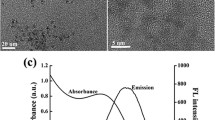Abstract
The sialic acid (SA)-phenylboronic acid (PBA) recognition system is of particular interest in the bioconjugation field, because it is simple, fast, efficient, and biocompatible. In this paper, we report a novel method for reversibly labeling living virus with quantum dots (QDs) by taking advantage of this SA-PBA recognition system. The QDs were initially modified with PBA (QDs-PBA) to target them to the surface of vesicular stomatitis virus (VSV), which has abundant with SA on its envelope. The QDs-PBA was of good monodispersity and strong fluorescence, and could be conjugated with VSV by simply incubating with native VSV for 10 min at 37 °C, producing QDs-VSV that was capable of being imaged at the single virion level. The labeling efficiency attained 83 ± 4.3 % (mean ± SD); meanwhile, the activity and recognition ability of the labeled virus were minimally affected. This method was simple, rapid, and reversible. This work promotes the virus labeling development to a new step. That is, native viruses can be reversibly labeled without any modification.

Initially, the 3-amino-phenylboronic acid (APBA) reacted with QDs-COOH to prepare the PBA capped QDs (QDs-PBA). Then, the vesicular stomatitis virus (VSV), on which the surface of the envelope is abundant with sialic acid (SA), could be labeled efficiently and specifically with QDs-PBA in one step based on sialic acid-phenylboronic acid recognition system. The labeling efficiency attained to (83 ± 4.3 %) (mean ± SD). The labeled VSA (QDs-VSV) was still infectious and capable of being imaged at the single virion level





Similar content being viewed by others
References
Seisenberger G, Ried MU, Endress T, Buning H, Hallek M, Brauchle C (2001) Science 294:1929–1932
Ward BM, Moss B (2001) J Virol 75:4802–4813
You JO, Liu YS, Liu YC, Joo KI, Peng CA (2006) Int J Nanomedicine 1:59–64
Joo KI, Fang Y, Liu Y, Xiao L, Gu Z, Tai A, Lee CL, Tang Y, Wang P (2011) ACS Nano 5:3523–3535
Joo KI, Lei Y, Lee CL, Lo J, Xie J, Hamm-Alvarez SF, Wang P (2008) ACS Nano 2:1553–1562
Huang LL, Zhou P, Wang HZ, Zhang R, Hao J, Xie HY, He ZK (2012) Chem Commun 48:2424–2426
Hao J, Huang LL, Zhang R, Wang HZ, Xie HY (2012) Anal Chem 84:8364–8370
Liu SL, Zhang ZL, Tian ZQ, Zhao H, Liu HB, Sun EZ, Xiao GF, Zhang WP, Wang HZ, Pang DW (2012) ACS Nano 6:141–150
Liu HB, Liu Y, Liu SL, Pang DW, Xiao GF (2011) J Virol 85:6252–6262
Huang BH, Lin Y, Zhang ZL, Zhuan FF, Liu AA, Xie M, Tian ZQ, Zhang ZF, Wang HZ, Pang DW (2012) ACS Chem Biol 7:683–688
Huang LL, Lu GH, Hao J, Wang HZ, Yin DL, Xie HY (2013) Anal Chem 85:5263–5270
Otsuka H, Uchimura E, Koshino H, Okano T, Kataoka K (2003) J Am Chem Soc 125:3493–3502
Kim H, Kang YJ, Kang S, Kim KT (2012) J Am Chem Soc 134:4030–4033
Ellis GA, Palte MJ, Raines RT (2012) J Am Chem Soc 134:3631–3634
Li Y, Xiao W, Xiao K, Berti L, Luo J, Tseng HP, Fung G, Lam KS (2012) Angew Chem Int Ed 51:2864–2869
Lv CC, Li H, Wang H, Liu Z (2013) Anal Chem 85:2361–2369
Karnati VV, Gao X, Gao S, Yang W, Ni W, Sankar S, Wang B (2002) Bioorg Med Chem Lett 12:3373–3377
Fang H, Kaur G, Wang B (2004) J Fluoresc 14:481–489
Cambre JN, Sumerlin BS (2011) Polymer 52:4631–4643
Matsumoto A, Sato N, Kataoka K, Miyahara Y. (2009) J Am Chem Soc 131: 12022–12023
Matsumoto A, Cabral H, Sato N, Kataoka K, Miyahara Y (2010) Angew Chem Int Ed 49:5494–5497
Liu A, Peng S, Soo JC, Kuang M, Chen P, Duan HW (2011) Anal Chem 83:1124–1130
Han E, Ding L, Ju HX (2011) Anal Chem 83:7006–7012
Etchison JR, Holland JJ (1974) Proc Natl Acad Sci U S A 71:4011–4014
Cureton DK, Massol RH, Whelan SPJ, Kirchhausen T (2010) PLoS Pathog 6:e1001127
Kuralay F, Sattayasamitsathit S, Gao W, Uygun A, Katzenberg A, Wang J (2012) J Am Chem Soc 134:15217–15220
Polsky R, Harper JC, Wheeler DR, Arango DC, Brozik SM (2008) Angew Chem Int Ed 120:2671–2674
Khanal M, Vausselin T, Barras A, Bande O, Turcheniuk K, Benazza M, Zaitsev V, Teodorescu CM, Boukherroub R, Siriwardena A, Dubuisson J, Szunerits S (2013) ACS Appl Mater Interfaces 5:12488–12498
Acknowledgments
This work was supported by the National Basic Research Program of China (973 Program, no. 2011CB933600), the National Natural Science Foundation of China (No. 201372028) and the 863 program (SS2013AA031904).
Author information
Authors and Affiliations
Corresponding author
Electronic supplementary material
Below is the link to the electronic supplementary material.
ESM 1
(PDF 692 kb)
Rights and permissions
About this article
Cite this article
Huang, LL., Jin, YJ., Zhao, D. et al. A fast and biocompatible living virus labeling method based on sialic acid-phenylboronic acid recognition system. Anal Bioanal Chem 406, 2687–2693 (2014). https://doi.org/10.1007/s00216-014-7651-9
Received:
Revised:
Accepted:
Published:
Issue Date:
DOI: https://doi.org/10.1007/s00216-014-7651-9




